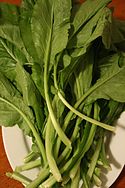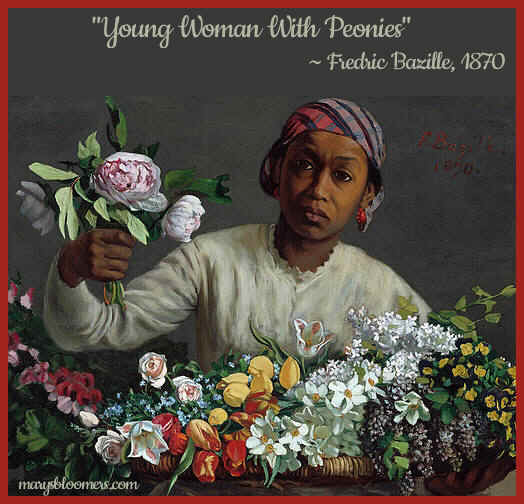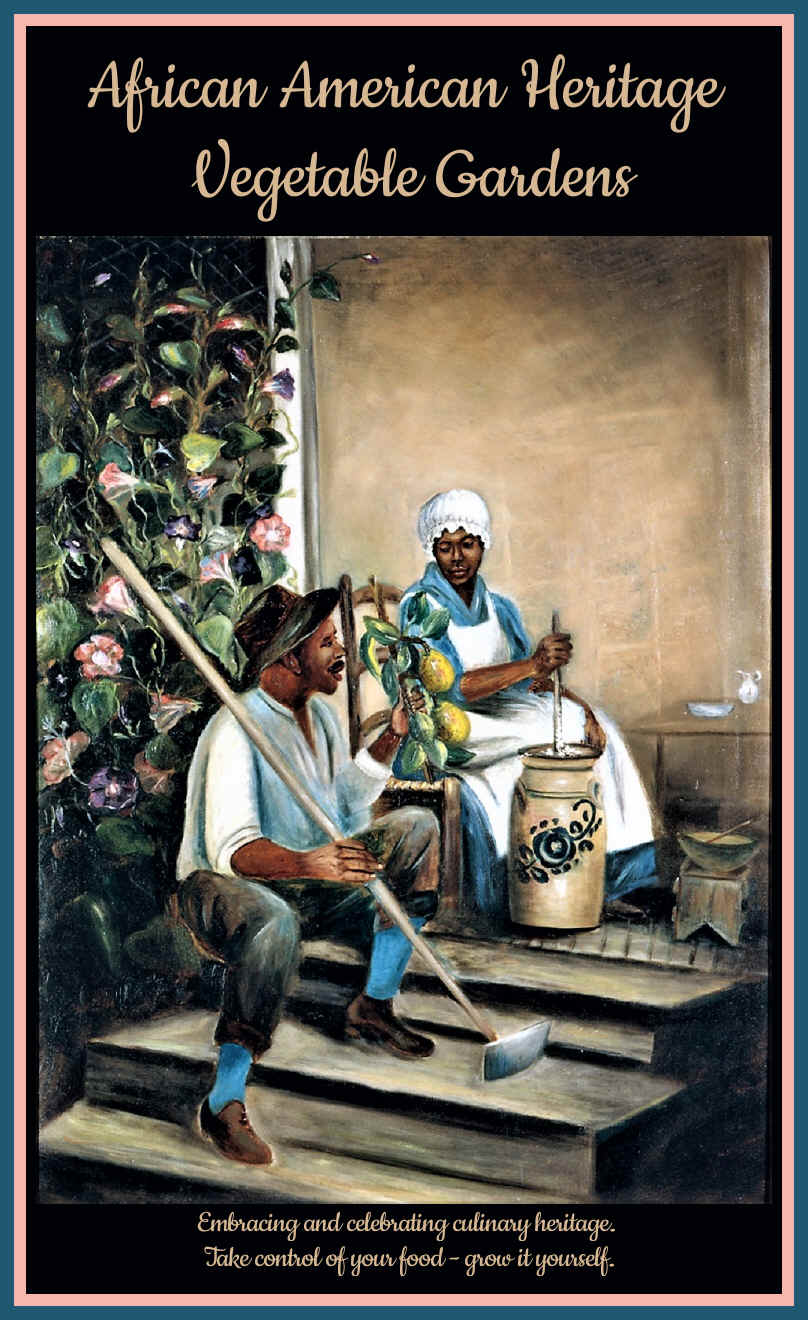 |
| Mary Lyde Hicks Williams (1866-1959) Mary's paintings of freed slaves reflected the daily life she saw on her uncle's plantation during Reconstruction |
|
Grow Your Food, Feed Your Soul |
|
Growing African Diaspora and Community Gardens There's a lot of history behind the delicious cuisine growing in the African American Diaspora garden. There are many "food deserts" in the U.S. that make it difficult, and sometimes impossible, for people from diverse cultures to find the food and ingredients needed to perpetuate their culture's culinary heritage. Unavailability of those traditional foods used in the cuisines of African American cultures in certain areas of the country, drives the need to grow their own traditional or community food gardens based on that culture. And all of us need food and economic independence. There's no better way to celebrate your food heritage and its culinary delights than to plant a garden full of the food you love, and those that your ancestors grew. Whether you call it Soul Food, or any other descriptive name, it's worth designing a garden filled with vegetables your ancestors grew, food you grew up with, or a Foodie Garden for those like me who love the flavor combinations of recipes created using these vegetables. I call them "specialty" or "ethnocentric" gardens and crops. Because I have a hard time finding those heirloom plants. I don't do seeds, so I have to search. But those garden theme names are too simplistic The expression "soul food" originated in the mid-1960s, when "soul" was a common word used to describe African American culture. This article isn't just about "soul food" as a style of cooking, it encompasses the traditional foods used in African American cuisine and culture. Today, we associate it with "Comfort Food". According to Afroculinaria, Soul Food is the memory cuisine of the great-grandchildren of the enslaved, not the food that the enslaved ate. Out of the horrors and brutality of slavery, a beautiful culture of food and survival emerged that is still prevalent in the southern U.S, and celebrated in almost every city today. Rural church suppers and picnics throughout the south often feature these cultural favorites, and I was not the only one drooling in anticipation of perfectly crispy and juicy fried chicken, crispy fried catfish, and barbecued ribs, which I have tried time and time again to re-create and never got quite right. The Baptist Church picnics and Sunday suppers I attended with a friend came with mature African American Grandma Church Ladies dressed in their Sunday best floral dresses, and big hats decorated all over with the most astonishing fabric flowers and birds. A Bible was held under the arm carrying the handbag, which was big enough to teach you a lesson. I had spent almost a decade studying the Gullah folk of Charleston, learning their history, customs, and eating their unique and delicious cuisine. And I still can't perfect my favorites. I have experienced many "secret" barbecue shacks off the beaten path, that open only on particular days, and close down during the brutal heat of full summer... that had huge roasting pits out back, where Mr. Pig and huge amounts of ribs slow-roasted all day long. You knew what time he'd be ready. And you made sure to be there to greet him. The style of cooking originated during American slavery, and continued through reconstruction, when slaves were freed, and meat was no longer rationed. African American cuisine and Soul Food originally came from the dishes that were created using the meagre rations allowed to African Americans by English Americans on southern plantations. Just enough food to keep the slaves alive. Due to the historical presence of African Americans in the region, soul food is closely associated with the cuisine of the American South, although today it has become an easily identifiable and celebrated aspect of mainstream American food culture everywhere. African slaves were given only the leftover and undesirable cuts of meat from their masters. Slaves also had only vegetables they had grown for themselves. After slavery, many, being poor, could afford only off-cuts of meat. Farming, hunting and fishing provided fresh vegetables, there were fish and wild game, such as possum, rabbit, squirrel and sometimes waterfowl. The intersections of African food preparations preserved , class status, laws that prevented equal access and innovative survival prevailed. Africans living in America at the time of slavery more than made do with the food choices they had to work with. Some History The origins of recipes considered soul food can be traced back to before slavery, as West African and European foodways were adapted to the environment of the region. Many of the foods integral to the cuisine originate from the limited rations given to enslaved people by their planters and masters. Most enslaved people needed to consume a high-calorie diet to replenish the calories spent working long days laboring in the fields, or performing other physically arduous tasks. This led to time-honored soul food traditions like frying foods, breading meats and fishes with cornmeal, and mixing meats with vegetables (e.g. putting pork in collard greens). Eventually, this slave-invented style of cooking was adopted into larger Southern culture, as slave owners began to give special privileges to slaves with cooking skills. For the majority of the United States’ colonial history, slave gardens were vegetable gardens. Because a slave’s “free” time mostly consisted of Sundays and the hours of darkness, they favored plants that could take care of themselves without too much tending. There were other commonalities, too. They needed high-yield plants, ones that could produce a lot of food in a small space. Succession planting was important as well, the ability to sow seed every couple weeks, to ensure that something would always be ready to pick. Storage and preservation was essential for the wintertime, but slave gardens didn’t need anything as fancy as canning. Many of the root vegetables could be stored safely in the ground, and others, such as the peas and beans, were preserved by drying. Collards and kale would survive rooted throughout winter, and chickens kept the pests down and provided protein with their eggs. Impoverished whites and blacks in the South cooked many of the same dishes stemming from the soul tradition, but styles of preparation varied. Certain techniques popular in soul and Southern cuisines (i.e., frying meat and using all parts of the animal for consumption) are shared with ancient cultures all over the world, including China, Egypt, and Rome. The magazine Ebony Jr, was important in transmitting the cultural relevance of soul food dishes to middle-class African-American children, who typically ate a more standard American diet. Soul food is frequently found at religious rituals and social events such as church suppers, picnics, funerals, fellowship, Thanksgiving, and Christmas in the Black community. |
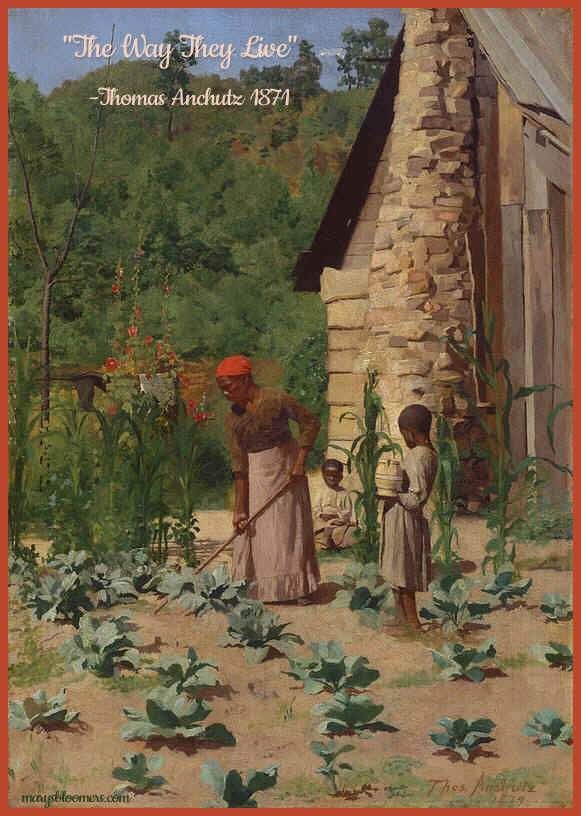 |
There is substantial African influence found in comfort and soul food recipes, especially from the West and Central regions of Africa. This influence can be seen through the heat level of many soul food dishes, as well as many ingredients found within them. Peppers used to add spice to food included malagueta pepper, as well as peppers native to the western hemisphere such as red (cayenne) peppers. Several foods that are essential in southern cuisine and soul food were domesticated or consumed in the African savanna and the tropical regions of West and Central Africa. These include pigeon peas, black-eyed peas, okra, and sorghum. It has also been noted that a species of rice was domesticated in Africa, thus many Africans who were brought to the Americas kept their knowledge for rice cooking. Rice is
a staple side dish in the Low country region and in Southern Louisiana. Rice is
the center of dishes such as jambalaya and red beans and rice which are popular
in South Carolina and Southern Louisiana. |
|
The Slave Gardens From the beginning of the transatlantic slave trade, food was both a form of resistance, and a tool of control, over enslaved people. Over the course of 400 years, millions of enslaved Africans were forcibly transported to the Americas and the Caribbean across the Atlantic Ocean. This forced migration is known as the Middle Passage. Slavers used a rigorous system of brutal violence to turn human beings into “commodities” during the Middle Passage. Food was an important element of this process. Rations were scientifically calculated to provide the cheapest, minimal nutrition to keep enslaved people alive. Slaves’ diets were frequently a primary point of debate between abolitionists and slaveholders, with pro-slavery supporters using rations to “prove” the good quality of life African Americans had under slavery. Slave gardens were often called “truck patches”. Before the invention of automobiles, “truck” meant market-garden produce, a definition which leads directly to the description of today’s farmers market vendors as “truck farmers.” During the time when these slave gardens were being described, it had a different meaning, namely the payment of wages in goods instead of money. That definition itself emerged from an even older sense of “truck,” meaning commodities for barter. These were simply small bits of land allowed to the slaves to grow their own food on, saving the white slave owners money, and justifying cutting food rations. |
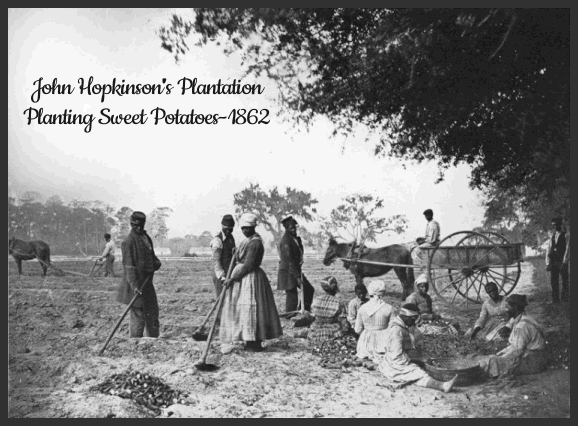 |
Though rations took away the power of choice, slaves could supplement their meals by hunting, fishing and gardening. Slaves cared for their own personal gardens, and passed down practices and preferences to their families. Gardening gave slaves an avenue to make their own choices about their diets. Slaves had to tend to their gardening or other food procurement on their own time at night, after laboring on the plantation for a full day. Growing in a slave garden would be beans, field peas like black-eyed, squashes, greens like collard, mustard, turnip and cabbage, onions, potato and yam, eggplants, along with peanuts, gourds for making dippers, corn, and some fruit, too, like apples, stone-fruits and melons. There was even some livestock. Mostly chickens. |
|
Slaves would gather and boil various kinds of leafy foods, such as collards, kale, the tops of beets and turnips, or wild weeds. In various instances, slaves boiled greens that were traditional to some Native American cuisines, like marsh marigold and milkweed. Slaves would flavor the dish by boiling a piece of pork fat or bacon with the vegetables. Since slaves received such poor cuts of meat, their rations were often more ideal for flavoring foods, rather than serving as a meal itself. Enslaved people ate some form of corn at almost every meal, and they created a variety of ways to prepare it, drawing inspiration from their Native American neighbors. In the seventeenth century, many enslaved Africans may have noticed similarities between their cultures. Native Americans shared their expertise of growing and preparing maize with both Africans and Europeans, including the art of making bread from corn instead of wheat. To prepare this bread, Native Americans created dough from cornmeal and water, covered the dough with leaves, and then placed the covered dough in hot ashes to bake. This recipe and technique is almost identical to the ways many slaves would make breads variously called hoecake, ash-cake, spoon bread, corn pone (the word pone comes from the Algonquian word apan), and cornbread. Irene Robertson, a former slave from Arkansas, had the following recipe for bread: “Sift meal, add salt and make up with water, put on collard leaf, cover with another collard leaf, put on hot ashes. Cover with hot ashes. The bread will be brown, the collard leaves parched up…” Cornbread also related to the cruelties of forced bondage. Enslaved people, who were given limited rations and limited time to eat and prepare their meals, became heavily reliant on cornbread. Cornbread and its varieties were ideal for slaves who worked in the fields, because it did not require utensils, could be easily transported, and it could last a long time. Most slaves were given little or no breaks for meals. Cornbread was also an easy food for enslaved children to prepare. Enslaved people were typically given a peck (8 dry quarts) of cornmeal and 3-4 pounds of pork per week, and from those rations came African American food staples such as cornbread, fried catfish, barbecued ribs, chitterlings, and neck bones. It has been noted that enslaved Africans were the primary consumers of cooked greens (collards, beets, dandelion, kale, and purslane) and sweet potatoes for a good part of US history. Several of the ingredients included in
African American and Soul Food recipes have pronounced
health benefits. Peas and legumes are inexpensive sources of protein; they also contain
important vitamins, minerals, and fiber. Collard and other greens are rich sources of several vitamins
(including vitamins A, B, folic acid, vitamins K and C, minerals (manganese, iron, and calcium), fiber, and small
amounts of omega-3 fatty acids. They also contain a number of phytonutrients,
which are said to play a role in the prevention of certain cancers. Word to the wise.... For centuries, African American and Soul food has been cooked and seasoned with pork products, and fried dishes are usually cooked with hydrogenated vegetable oil (shortening or Crisco, which is a trans fat). Regular consumption of these ingredients without significant exercise or activity to work the calories off, often contributes to disproportionately high occurrences of obesity, hypertension, cardiac/circulatory problems and/or diabetes. |
Popular Vegetables and Legumes Grown In The African American Food Garden**Beans, greens and other vegetables are often cooked with ham or pork parts to add flavor.
|
|
What to grow: Grow What You Love To Eat and Share With Friends and Family Suggested plants for your African American Heritage or Soul Food Garden
In the south, "Many Black
Americans are keeping alive the gardening traditions based on
resourcefulness, self-reliance and ingenuity that shaped the rural
gardens of their forebears, many of them slaves. These garden traditions
have evolved in circumstances of great hardship and oppression, but, in
spite of that, the yards display a quality of creative improvisation
that is a remarkable demonstration of the human spirit. Many Blacks
today, because of the years of slavery and oppression, have ambivalent
feelings toward their agrarian heritage of slavery and sharecropping. In
the rural south, the term "garden" is for the place where
vegetables like tomatoes, collard, corn, watermelon, squash and butter
beans are grown." Where
to get Seeds and Plants For Your African American Heritage Garden African American Community Gardens in Pennsylvania-->
|
Resources: Sun Sentinel |
|
|
|
|
|
eyecandee.com
|
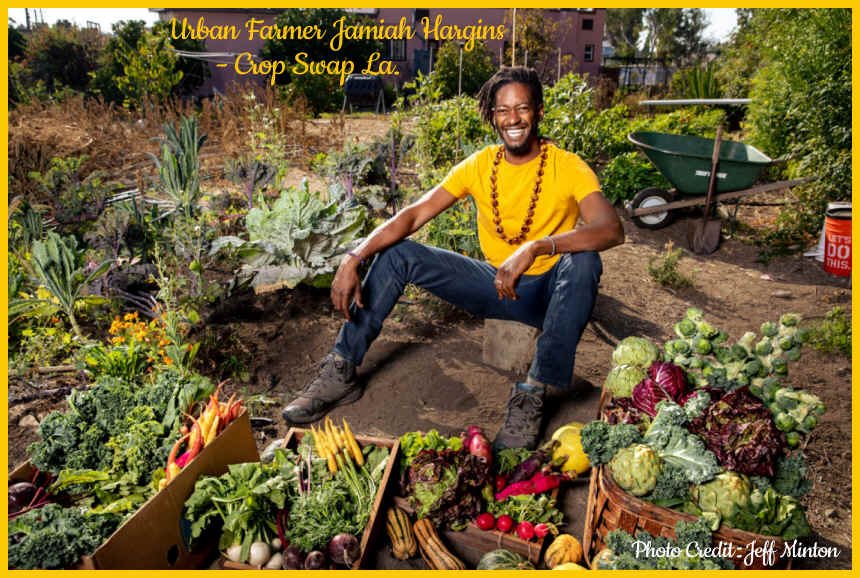
_(2).jpg/125px-Mmm..._black_eyed_peas_with_smoked_hocks_and_corn_bread_(7046315845)_(2).jpg)

